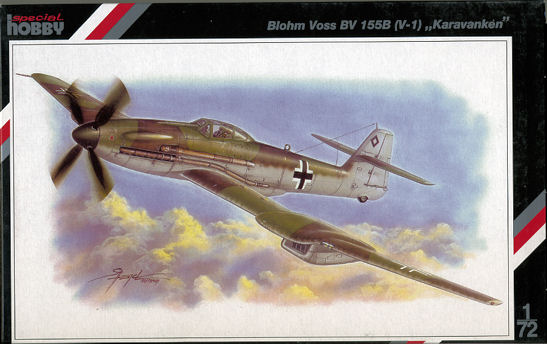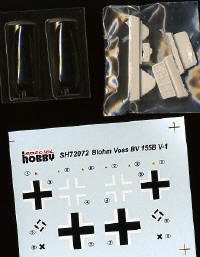
| KIT: | Special Hobby 1/72 Bv-155v1 |
| KIT #: | 72072 |
| PRICE: | $27.15 from www.greatmodels.com |
| DECALS: | One option |
| REVIEWER: | Scott Van Aken |
| NOTES: | Short run with resin exhaust |

| HISTORY |
From a tail-hook fighter flying from aircraft carriers to a high-altitude bomber interceptor, the Blohm & Voss BV 155 had an interesting and convoluted development history. It was also one of the most technically advanced propeller-driven airplanes developed by any combatant during World War II. In May, 1942, the Reichluftfahrtministerium (German Air Ministry or RLM) convened a meeting with Focke-Wulf and Messerschmitt representatives to review requirements for two new aircraft development projects. One was a single-engine fighter to operate from aircraft carriers, the other specification described a Spezial Höhenjäger, an airplane capable of intercepting bombers at high altitudes and conducting reconnaissance as a secondary mission. The two firms were then fully engaged in building the Fw 190 and Bf 109 and they expressed concern about trying to develop two very ambitious designs on top of existing commitments. Focke-Wulf decided to ignore the carrier fighter and concentrate on the high-altitude interceptor proposal. Two years later, the firm met the high-altitude fighter requirement magnificently with the Focke-Wulf Ta 152H (also in the NASM collection).
In 1943, the RLM identified an offshoot high-altitude fighter concept known as the Extremer Höhenjäger, or extreme high-altitude fighter. To meet this need, the Messerschmitt designed the Me 155B and after a clumsy, protracted development period, Blohm & Voss took over and transformed the design into a promising, though technically challenging experimental aircraft called the BV 155.
From the May 1942 concept for a carrier-based fighter designated the Bf 109 ST, Messerschmitt proposed three variants: two versions of the naval fighter with different engines and a high-altitude interceptor equipped with the Jumo 213. The company soon merged the two carrier-based designs into a concept called the Me 155A. The bomber interceptor became the Me 155B. Both designs used many components from the Bf 109G, except for the wing and landing gear. Although these concepts showed promise, the work rapidly overtaxed Messerschmitt's design department and the firm transferred the Me 155B project to a new design office in Paris staffed by French aircraft designers. This group was, understandably, less than totally dedicated to the effort.
When Germany stopped work on all major surface vessels in January 1943, the Me 155A carrier airplane was cancelled too. French progress to develop the Me 155B was so slight that Messerschmitt stopped the work and refocused its own design staff on developing the Me 209 (a pre-war design that set a world speed record in 1939) to meet the Extremer Höhenjäger requirement. But the RLM would not let Messerschmitt drop the Me 155B. To speed progress the RLM paired Dr. Richard Vogt, chief designer at Blohm & Voss, and several hundred of his engineers and fabricators, with Messerschmitt. Both parties worked well together at first but over the next few months, the relationship soured. Messerschmitt could not resolve many critical decisions about the design including wing layout, engine, and engine coolant radiator design. Late in January 1944, the RLM directed Messerschmitt to transfer the whole project to Blohm & Voss and the BV 155 was born.
Dr. Vogt, and his team almost completely reworked the design and in the end selected the Daimler-Benz DB 603 U engine and the Heinkel-Hirth TKL 15 turbosupercharger to power the airplane. He also finalized the armament configuration and selected one MK 108 30-mm cannon in the nose and two 20 mm MG 151 cannons the wing. By late June 1944, Blohm & Voss planned to build three B-series prototypes and an improved version called the BV 155C. After RLM officials inspected the program in August, they were satisfied with progress enough enough to codename the project 'Karawanken' after a mountain range bordering Austria and Yugoslavia.
Vogt and his group created an impressive design. The BV 155 featured an armored, pressurized cabin with an ejection seat, high aspect ratio laminar-flow wings, wide-track landing gear, and a very advanced, though troublesome and complex, propulsion system.
An airscoop located on the underside of the fuselage at the trailing edge of the wing fed outside air to the TKL 15 turbo-supercharger. The supercharger compressed the air and fed it to an intercooler mounted above. A pipe semi-recessed into the left fuselage (visible below the cockpit and above the long exhaust pipe) fed the cooled, high-pressure air from the intercooler forward to the engine-driven supercharger. The RLM wanted the airplane to fly near 16 km (52, 490 ft) above the earth. Both a turbo-supercharger (driven by exhaust gases) and a mechanical supercharger (driven by a geared shaft off the engine) were the Vogt team's solution to this problem.
The mechanical supercharger pressurized the air again and fed it directly into the DB 603 U intake manifold. After the combustion cycle, semi-recessed exhaust pipes on both sides of the fuselage fed the hot exhaust aft. On both sides of the fuselage below the cockpit, the exhaust pipes angled down and split into two smaller pipes per side. Two pipes fed hot exhaust to turn the turbosupercharger and the other two pipes carried exhaust gases through a wastegate valve and exited the airplane. The wastegate valves regulated the pressure output of the turbosupercharger. Opening the valves dumped more exhaust overboard and slowed the turbo, reducing pressurized air to the engine. Blohm & Voss designed the whole power system to propel the BV 155 to speeds of about 692 kph (430 mph) at over 15,200 m (50,000 ft).
The war situation was worsening and the company moved the prototypes into newly armored hangars at Finkenwerder. Blohm &Voss completed the BV 155B V1 (V for Versuch, German for experiment) and scheduled the first flight for mid January. On February 8, 'V1 took to the air but the right radiator leaked badly and chief test pilot Helmut "Wasa" Rodig terminated the flight. Following repairs, the aircraft flew twice more on February 10 and 26. Repairs followed each flight but it is doubtful that the airplane flew again after the 26th.
| THE KIT |
 Molded
in MPM's usual somewhat soft grey plastic, the kit relies somewhat on resin for
detail bits and has two nicely molded vacuformed canopies. The resin is used for
some cockpit detail bits and the two large radiator grilles. Large plastic pi
Molded
in MPM's usual somewhat soft grey plastic, the kit relies somewhat on resin for
detail bits and has two nicely molded vacuformed canopies. The resin is used for
some cockpit detail bits and the two large radiator grilles. Large plastic pi eces
have ejector towers that will probably have to be removed before gluing the
parts together. The long wings are designed in such a way that the outer
sections are somewhat overlapping and the inner lower section is one piece that
includes the wheel well openings. This should make things nice and solid. The
kit's four bladed prop is molded in two pieces that interlock with each other to
give a single four bladed prop. Wheel wells are built up using several smaller
pieces for the inner walls. There is some flash on a few of the pieces, but
nothing troublesome.
eces
have ejector towers that will probably have to be removed before gluing the
parts together. The long wings are designed in such a way that the outer
sections are somewhat overlapping and the inner lower section is one piece that
includes the wheel well openings. This should make things nice and solid. The
kit's four bladed prop is molded in two pieces that interlock with each other to
give a single four bladed prop. Wheel wells are built up using several smaller
pieces for the inner walls. There is some flash on a few of the pieces, but
nothing troublesome.
Instructions are well done with several additional drawings showing the alignment of parts and how things should look in the end, something that is quite helpful. All the painting information for colors used during the build is given in Humbrol paint numbers without any generic reference as to what these colors actually are, From what I can figure out, Special Hobby would have you paint the interior and the landing gear legs/wheel wells with the same colors, which is contrary to the norm. I would suggest RLM 66 for the interior and RLM 02 for the gear and wells. Markings are for one aircraft in RLM 81/82/76. As is the norm with prototypes, the decals are generic, providing insignia and some data markings. They are well printed and should work just fine.
| CONCLUSIONS |
I'm glad to see this kit produced as it is a neat one. It is a bit of a surprise as there are no other variants that can be done from these sprues, something that is almost a requirement for an injected plastic kit nowadays. It should be a pleasant build and will definitely add to any collection of Luftwaffe prototypes.
| REFERENCES |
http://www.nasm.si.edu/research/aero/aircraft/blohm_voss.htm
March 2007
You can find this and many other interesting kits and accessories at
GreatModels
If you would like your product reviewed fairly and quickly by a
site that has over 350,000 visitors a month, please
contact
me or see other details in the
Note to
Contributors.